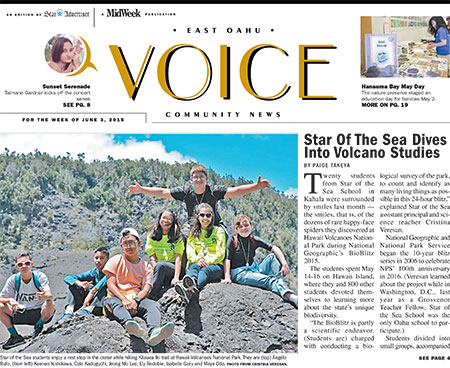Star Of The Sea Dives Into Volcano Studies
Twenty students from Star of the Sea School in Kahala were surrounded by smiles last month — the smiles, that is, of the dozens of rare happy-face spiders they discovered at Hawaii Volcanoes National Park during National Geographic’s BioBlitz 2015.
The students spent May 14-16 on Hawaii Island, where they and 800 other students devoted themselves to learning more about the state’s unique biodiversity.
“The BioBlitz is partly a scientific endeavor. (Students are) charged with conducting a biological survey of the park, to count and identify as many living things as possible in this 24-hour blitz,” explained Star of the Sea assistant principal and science teacher Cristina Veresan.
National Geographic and National Park Service began the 10-year blitz series in 2006 to celebrate NPS’ 100th anniversary in 2016. (Veresan learned about the project while in Washington, D.C., last year as a Grosvenor Teacher Fellow. Star of the Sea School was the only Oahu school to participate.)

Star of the Sea students enjoy a rest stop in the crater while hiking Kilauea Iki trail at Hawaii Volcanoes National Park. They are (top) Angelo Rufo, (from left) Keenan Yoshikawa, Cole Kadoguchi, Jeong Mo Lee, Ely Redoble, Isabelle Gary and Maya Oda. PHOTO FROM CRISTINA VERESAN.
Students divided into small groups, accompanied by adult scientists, to “inventory” the biological landscape. Some grabbed binoculars and tried to spot native birds in the foliage, while others searched for insects (including that score of baby happy-face spiders) and took notes about plant life.
“They were amazed at how much life is just unseen. You walk by a tree, you don’t see any insects — they’re really not visible until you get in there and shake them out and really take a close look,” Veresan said.
Veresan also was impressed at how BioBlitz tied its scientific endeavors with Hawaiian cultural practices, as the event began and ended with Hawaiian chants, and there was a cultural fair with hula, crafts, activities and music.
Of course, no trip to the Big Island would be complete without a tour around park’s volcanoes. The students explored pahoehoe lava flows, hiked the Kilauea Iki trail and visited the Jagger Museum’s overlook at night to watch the crater glow.
“The students were fascinated that, out there, on what looks to be this barren lavascape, you’ve got tiny plants beginning to grow in the cracks. … I think the kids were really struck by that cycle of devastation and renewal.”
Veresan is confident that the lessons learned at BioBlitz have returned to Oahu with the class.
“Hawaii really does have very special, unique ecosystems, and our bio-diversity is impressive because of the number of native and endemic species, but due to habitat loss and invasive species, these ecosystems are under threat and must be protected,” she said.
“(Students) were inspired to malama Hawaii, to care for Hawaii. …
“Since we’ve been back, a lot of the comments I’m getting from students are, ‘What can we do to help protect biodiversity?’
“This is real understanding of how we are all connected to a healthy, biodiverse environment.”






